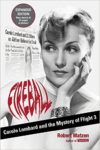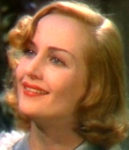The December 7, 1941, attack on Pearl Harbor changed America and Hollywood was no exception. Less than three months earlier, A U.S. Senate subcommittee held hearings on whether Hollywood was intentionally producing “propaganda” to encourage the country to enter the war in Europe. Pearl Harbor brought that investigation to a halt and within 10 days President Franklin Roosevelt appointed a “coordinator of government films” to advise Hollywood in supporting the war effort. And just 40 days after Pearl Harbor, the first Hollywood star would die in pursuit of that goal.
Known for her beauty and roles in popular screwball comedies, Carole Lombard was one of the highest paid actresses in the 1930s. She appeared in more than 30 films that decade. In fact, in 1999 the American Film Institute placed her 23rd among women on its list of the 50 greatest female American screen legends. Lombard was also the envy of many female moviegoers, eloping with Clark Gable while he was shooting Gone with the Wind in 1939. Gable would be devastated and Hollywood shocked when, on January 16, 1942, Lombard died at age 33 when a commercial airplane slammed into a mountain some 7,000 feet up southwest of Las Vegas.
 Fireball: Carole Lombard and the Mystery of Flight 3 details the seemingly fortuitous events that led to Lombard being on the flight as she returned from heading a war bonds drive. Originally released in 2014, an expanded trade paper edition was released last month on the 75th anniversary of the crash. After the book was initially published, additional remains were found at the remote crash site and DNA testing identified one of three previously unidentified victims. Author Robert Matzen weaves this and additional information into the anniversary edition.
Fireball: Carole Lombard and the Mystery of Flight 3 details the seemingly fortuitous events that led to Lombard being on the flight as she returned from heading a war bonds drive. Originally released in 2014, an expanded trade paper edition was released last month on the 75th anniversary of the crash. After the book was initially published, additional remains were found at the remote crash site and DNA testing identified one of three previously unidentified victims. Author Robert Matzen weaves this and additional information into the anniversary edition.
Using numerous interviews, a personal climb to the crash site and government documents, Matzen constructs the story deliberately. Roughly the first half of the book alternates between laying out Lombard’s life and the events leading up to the crash. The idea of sending movie stars on tours to sell war bonds was pitched to the Hollywood Victory Committee, of which Gable was a chair. Lombard had a movie scheduled for release in January 1942 so she opted to do the kickoff tour. Yet she never should have been on the plane.
With the tour heading to Lombard’s home state of Indiana, she asked her mother to go along. Called “Petey” by family and friends, Lombard’s mother hated flying and agreed to go only if there was no air travel. The War Department had barred stars on bond tours from traveling by air so Lombard assured Petey they would travel by train. Gable asked MGM press agent Otto Winkler, who worked closely with Gable, to accompany Lombard and her mother.
The trip to Indianapolis, departing January 12, included stops in Salt Lake City and Ogden, Utah, as well as Chicago. Lombard was scheduled to return January 19, the day her new film, To Be or Not to Be, was due to sneak preview. Co-starring Jack Benny, the film was a dark comedy about a company of Shakespearean actors in Poland when Germany invaded. Gable, meanwhile, left January 9 for New York City. Before leaving that day, however, he and Lombard fought over Gable’s purported interest in Lana Turner and her friendship with Robert Stack. He stormed out of their house.
In Chicago, Lombard decided to fly to Indianapolis while her mother stayed on the train. Her day in Indianapolis drew thousands of people and sold more than $2 million in war bonds. Because of the convenience of flying there and impatient to return home to Gable, Lombard convinced high-ranking officials to give her priority for a plane trip home. When Winkler and Petey strongly objected, Lombard agreed a coin flip would decide. She won.
Due to delays leaving Indianapolis the next morning and at five stops en route, the plane refueled in Las Vegas rather than the originally planned Boulder City, Nev. There, however, sat enough Army Air Corps men who could fill the TWA DC-3 and bump its current passengers. Even threatening to call Howard Hughes, TWA’s owner, Lombard convinced the counter agent to let her party stay on the plane. Some 13 minutes after take-off on a moonless night, the plane flew into a granite cliff some 7,800 feet up Mt. Polosi at 180-200 miles per hour. The impact was such that the nose of the plane stuck in the rock of the cliff.The terrain quickly challenged any thoughts of rescue. Even using what were barely paths through the rock strewn terrain left everyone some 2,000 feet shy of the crash site. Even horses couldn’t make it to the site; it was necessary to climb by hand through a steep boulder strewn ravine. Hopes disappeared when the first personnel reached the site the next morning.
[It] looked for all the world like the city dump. Luggage everywhere; the twisted fuselage of the plane, a tangled mass of aluminum, wires and cables, seats, shattered glass, random hunks of engine, and melted rubber. Wedged in here and there were passengers, or rather, what was left of passengers; pieces of passengers.
After Gable was notified, he flew in and demanded to be taken to the scene while efforts were being made to locate his wife’s body. Once there, he broke away from his handlers and tried to climb the mountain before realizing it was impossible. He retreated to a nearby hotel and casino where he sat in shock and drank.
Although Lombard and Gable are the centerpiece, Fireball recognizes she wasn’t the only casualty. Matzen relates the stories of Petey and Winkler, the three-person flight crew and several of the 15 Army Air Corps personnel on the plane. He also details the experiences of those who searched for the plane and helped recover the bodies as well as several passengers who were bumped because of the priority afforded the military men.
Matzen’s narrative nonfiction approach makes the book highly readable but it relies on a trait of that style that irritates some readers — it takes us into the unknowable reactions and minds of individuals. For example, Matzen tells us what Petey was thinking on the first leg of the flight. He describes the thoughts of several airmen sitting in the terminal awaiting the flight in which they would die. We are told “Gable’s skin crawled over his bones” on boarding his flight to Las Vegas and his thoughts of Petey while sitting in the hotel room.
Still, Matzen examines the crash from all aspects, including how an experienced pilot and co-pilot could fly into a mountain miles off course. The crash preceded so-called “black box” recorders and the plane’s instrumentation was so destroyed that it was of no use. No official cause was ever established but even the possibility of sabotage was considered. Some believe the course and altitude that took the plane into the side of a mountain were those recorded in the initial flight plan for a departure from Boulder City.
Fireball looks at more than just the story of a plane crash. It tells us of Lombard’s and Gable’s lives, both individually and as a couple. It gives insight into the effects of the crash on the families of the victims. It also explores Hollywood of that era, looking at not only the studios and social life but the day-to-day concerns, such as the MGM representatives with Gable in Nevada who were worried about what would happen “if Gable went up there and fell off the goddamn mountain.”
After all, that “goddamn mountain” was already responsible for a gruesome and singular tragedy.
It was a train wreck of awful.
Robert Matzen, Fireball








